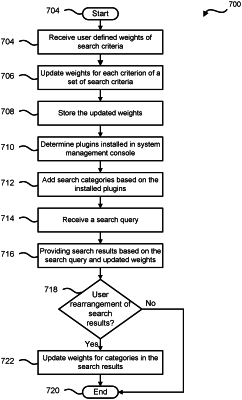| CPC G06F 16/24578 (2019.01) [G06F 16/9535 (2019.01)] | 15 Claims |

|
1. An information handling system comprising:
a first memory to store user settings for performing a search in a system management console;
a second memory to store data associated with components of the system management console; and
a processor to communicate with the first memory and with the second memory, the processor to:
receive a plurality of user defined weights, wherein each of the user defined weights is associated with a different search criterion of a plurality of search criteria, wherein the user defined weights are received based on a movement of a search category to a new location in a search category list;
based on the received user defined weights, update weights for each of the search criteria;
increase weights for devices that are tagged as cluster devices;
store the updated weights for each of the search criteria and the increased weights for the devices in the user settings of the first memory;
receive a search query;
determine a percentage of devices in a particular group of devices that the user has a management domain over;
search based on the search query only the percentage of devices in the particular group of devices that the user has the management domain over;
provide search results based on the search query and the updated weights for each of the search criteria, wherein the search results include data from the second memory;
determine a user arrangement of the search results, wherein the user arrangement of the search results includes the search results being placed in an order that best describes the intent of the search during the browsing session;
based on the order of the search result created by the user arrangement of the search results, create search result weights for categories in the search results;
detect an end of the browsing session; and
in response to the end of the browsing session:
maintain the user defined weights; and
remove the search result weights from the first memory.
|